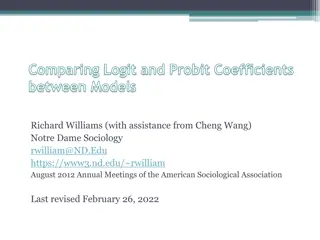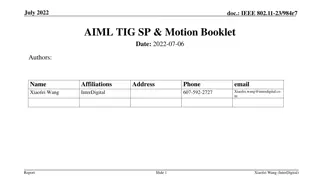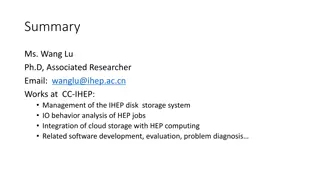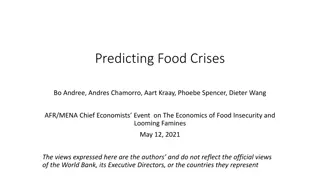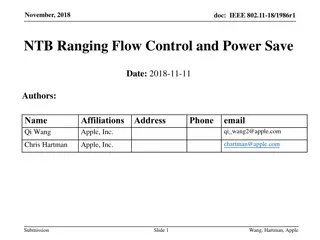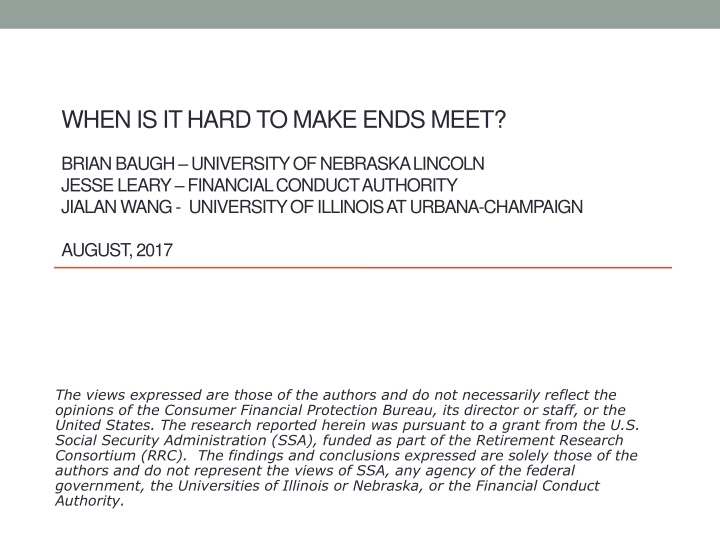
Challenges of Making Ends Meet: Income Timing and Financial Behavior
Discover the financial challenges faced by many Americans, from living paycheck to paycheck to struggling with unexpected expenses. Explore the impact of income timing on financial well-being for OASDI beneficiaries. Gain insights into the difficulties of managing finances and learn how to navigate financial hurdles effectively.
Download Presentation

Please find below an Image/Link to download the presentation.
The content on the website is provided AS IS for your information and personal use only. It may not be sold, licensed, or shared on other websites without obtaining consent from the author. If you encounter any issues during the download, it is possible that the publisher has removed the file from their server.
You are allowed to download the files provided on this website for personal or commercial use, subject to the condition that they are used lawfully. All files are the property of their respective owners.
The content on the website is provided AS IS for your information and personal use only. It may not be sold, licensed, or shared on other websites without obtaining consent from the author.
E N D
Presentation Transcript
WHEN IS IT HARD TO MAKE ENDS MEET? BRIANBAUGH UNIVERSITY OF NEBRASKA LINCOLN JESSE LEARY FINANCIAL CONDUCT AUTHORITY JIALAN WANG - UNIVERSITY OF ILLINOIS AT URBANA-CHAMPAIGN AUGUST, 2017 The views expressed are those of the authors and do not necessarily reflect the opinions of the Consumer Financial Protection Bureau, its director or staff, or the United States. The research reported herein was pursuant to a grant from the U.S. Social Security Administration (SSA), funded as part of the Retirement Research Consortium (RRC). The findings and conclusions expressed are solely those of the authors and do not represent the views of SSA, any agency of the federal government, the Universities of Illinois or Nebraska, or the Financial Conduct Authority.
2 Half of All Americans Live Paycheck to Paycheck One quarter to one half of households cannot come up with $2,000 in 30 days. (Lusardi, Schneider and Tufano 2011) Concurrent income and expense shock would cost the average family $4,800, but typical liquid assets are only $3,000 (JPMC 2015) Forty-six percent of individuals could not pay for a $400 emergency using available cash (Federal Reserve Board 2016)
3 Social Security Benefits Disbursement Schedule In 1997, the SSA started disbursing old age, survivor and disability insurance (OASDI) payments on the second, third, and fourth Wednesday of each month based on beneficiary date of birth This schedule generates pay periods that are either 28 or 35 days long We examine the effects of the Wednesday payment schedule on the financial behavior and financial health of OASDI beneficiaries
INCOME TIMING FOR OASDI BENEFICIARIES
5 Wednesday Groups are Paid at Different Times of the Month
6 About Four Pay Periods Per Year Are 35 Days Long 5 Wednesdays 35-day pay period
7 Long Pay Periods Are Evenly Distributed
9 Credit Cards and Bank Accounts from Large Account Aggregator Users who sign up for a free online service that automatically downloads information from bank and credit card accounts Transaction-level coverage between 2010-2015 Financial distress measures Overdrafts, bounced checks Online payday loans Other financial measures Categorized expenditures (cash, check, restaurant, etc.) Liquidity and savings Limited demographics in both datasets
10 Loan-level Data From Storefront Payday Lenders All loans from a number of large storefront payday lenders between 2010-2012 Tens of thousands of borrowers who receive Social Security benefits on one of three Wednesdays* 18% of all payday borrowers receive income from benefits or public assistance (CFPB, 2013) Unique features of payday loans Precisely-measured income source and income timing Requires pay stub to obtain loan Almost always due exactly on payday Requires bank account, so most receive benefits through direct deposit Timing and amount of loan use precisely measured at daily level * Precise details of sample size and sample period shrouded to protect lender identities
11 Typical Aggregator Household: $1,300 in Benefits Summary Statistics Per Household Month Has Has Late Mean Median Std. Dev. $4,535 $3,347 $1,346 $1,387 $3,189 $2,000 $6,705 $5,150 $2,607 $1,761 $1,788 $1,000 $647 $172 $2,021 $945 $2,078 $1,141 13% 0% 11% 0% 3% 0% 0.2% 0% Recurring Income Social Security Income Other income Expenses Recurring Credit Card Payment Mortgage Car Payment Cash and Check Other Financial Shortfalls Overdrafts Bounced Check Online Payday $4,139 $562 $4,110 $6,801 $2,874 $2,225 $1,149 $358 $4,659 $1,496 34% 30% 18% 4% 79% 70% 32% 23% 12% 12% 2% 3% $0 $0
12 Typical Payday Consumer: $1,000 in Benefits Panel A: Loan Terms at Origination Mean $352 $305 $47 352% $16 21.0 Median $306 $255 $45 282% $15 Std. Dev. $169 $149 Loan amount total Principal Finance charge APR Cost per 100 Contract duration (days) $25 260% $4 20 10.5 Panel B: Borrower Statistics Mean $962 7.0 1.1 5.9 $427 $370 196 Median $864 Std. Dev. $503 Monthly benefits income Total # of loan cycles # of fresh loans # of rollover cycles Total fresh credit Total fees Total days indebted 7 1 5 4.2 0.4 4.2 $400 $320 195 $224 $288 121 -> Our analysis only considers fresh loans, since rollover loans always begin and end on pay dates
13 SSA Benefit Distributions are Identical Across Wednesday Groups Account Aggregator Storefront Payday
DOES INCOME TIMING AFFECT FINANCIAL SHORTFALLS?
15 More Shortfalls During Long Pay Periods and Fewer For Fourth Wednesday Group Online Payday 0.01% Storefront Payday 0.05% Outcome: Sample Mean: OD Bounced 0.19% 0.70% Long pay period 0.047 (0.011) [0.001] 0.028 (0.011) [0.020] 0.162 (0.061) [0.017] 0.308 (0.062) [0.000] Third Wednesday 0.041 (0.011) [0.001] 0.110 (0.017) [0.000] 0.159 (0.058) [0.014] 0.002 (0.022) [0.925] - 0.026 (0.013) [0.059] - 0.104 (0.021) [0.000] - 0.142 (0.061) [0.033] - 0.036 (0.021) [0.107] Fourth Wednesday Table presents coefficients from regression analysis. Regressions include month, year, and day of month fixed effects. Standard errors are clustered by recipient group X year
WHY DOES INCOME TIMING MATTER?
17 We Test for the Role of Timing Mismatch Between Income and Expenditure Commitments Hypothesis: a) Shortfalls are correlated with timing mismatch between pay date and expenditure due dates b) Fourth Wednesday group has less mismatch because many large expenses are due near the beginning of the month, leading to fewer shortfalls Testing the predictions: Measure the timing of large recurring bill payments Measure timing mismatch Estimate effect of mismatch on shortfalls
18 Timing Mismatch Increases Financial Shortfalls Online Payday 0.01% 0.163 (0.049) [0.001] OD Bounced 0.19% 0.029 (0.010) [0.003] 0.70% 0.047 (0.005) [0.000] Sample mean Long day period Timing Mismatch (weeks) 0.096 (0.071) [0.178] 0.336 (0.108) [0.002] 0.467 (0.398) [0.240] R2 0.002 0.000 0.000
WHEN IS IT HARD TO MAKE ENDS MEET?
20 When is it Hard to Make Ends Meet? During predictably longer pay periods When there is greater timing mismatch between income and expenses Implications: Policies and technologies that help smooth income and align the timing of income and expenditures may make beneficiaries better off
21 What Can We Do About It? Change income timing Allow households to choose? New technologies Autopay and digital wallets Liquidity smoothing and prediction Low-hanging fruit: Encourage consumers to change their credit card due dates!

